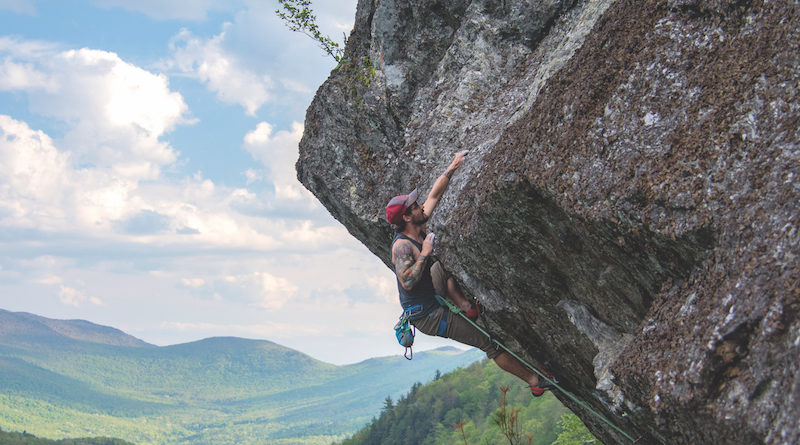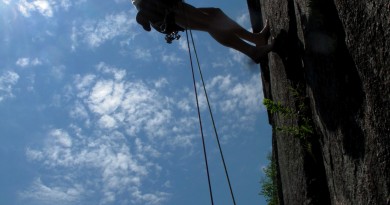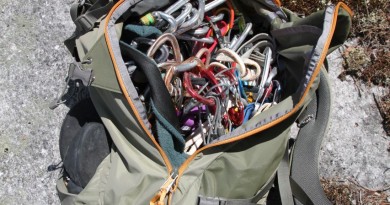The Climber
Name: Kris Fiore Age: 32
Lives in: Burlington
Family: Partner, Julia Shatten; father, Aaron; brother Josh; four-legged mutt, Knuckles
Primary sports: Rock climbing
Kris Fiore, the president of CRAG-VT (Climbing Resource Access Group), loves finding new routes. He has 85 first ascents (not including boulders) to his credit. Fiore coaches Ultimate Frisbee at Colchester High School and works at Petra Cliffs, but he says the only thing that gives him as much pleasure as climbing is his job as Director of Camp Unirondack in Lowville, New York.
Tell us about the new climbing festival that will take place this month at Cochran’s.
The Vermont Climbing Festival (September 20-22) will be Vermont’s first climbing festival. There will be gear demos and clinics. Professional climbers will be coming to speak, including Matty Hong, at 7 p.m. on Saturday, and he’s someone I’d drive three hours to hear. What we’re really excited about is the chance to get the community together, not to raise money, but just to enjoy and appreciate Vermont climbing.
Have you always been a climber?
I started climbing eight years ago, just before I moved to Burlington, but I got obsessed super quick. I started climbing because of Marissa Gorman, my former partner, whom I met at Plattsburgh State. I’d climbed indoors a few times, but she was an expeditionary studies major so she helped me move outside.
How did you become involved with CRAG-VT?
I moved to Burlington seven years ago and joined the board about two years later. I was vice president for two years and I’ve been president for two. Part of the reason is a desire to give back to the climbing community but also to make sure things are done the right way. Those of us on the board have seen climbing areas that were not managed well, and irresponsible climbing is bad for conservation efforts and the land. On the flip side, good, ethical and responsible climbing gives people an appreciation for the land they are using and breeds a sense of respect.
Let’s talk about the purchase of Bolton Dome.
Bolton Dome is the largest project CRAG-VT has ever taken on and it’s also the largest loan the Access Fund [a national climbing advocacy group] has ever given. That number is a little inflated because we purchased a house with the loan and then repaid most of it with the resale. CRAG-VT has been around for 20 years and we own three other properties but the scale of this project was much larger. In the 1980s this cliff was closed because people didn’t respect the land. People trespassed and continued to climb until a clear-cut made that impossible. When CRAG-VT was formed, we went to the landowners to ask for permission to climb and were turned down. We returned every five years or so and 18 years later, when they decided to sell, they gave us the first shot at purchasing the house and land. It was over $400,000 and we didn’t think we had any chance of making it happen but the Access Fund was willing to help. It’s pretty cool and something we’re really proud of. We’ll eventually do a conservation easement through the Vermont Land Trust and we’re in the process of finalizing a parking plan.
How have you managed so many first ascents?
Six years ago, I was climbing the Quarry in Bolton with Marissa and I saw a line of holds between two routes and thought it could be its own route. We didn’t know anything about bolting. I was at University of Vermont at the time—I guess the statute of limitations has run out so I can admit that I stole a drill and brought it out there. We were close enough to be able to charge the drill from the car but it wasn’t really up to the task as we shuffled back and forth between the car and the wall. It was the worst way to do it. Eventually I bought my own drill, but I was a graduate student so I planned to return it after we were finished. When it took me only eight seconds to drill a bolt, I realized I really enjoyed the process and kept the drill. We were so excited that we climbed the route while it was still wet. The end result was two mediocre routes that are really nothing to recommend so we called one “Where’s the Wrench?” and the other “I Thought You Had It” as an homage to the way we did it. I discovered I loved hanging on the ropes, checking for loose rock and seeing if it was safe. It was kind of a puzzle. When you get done, you have something you’re really proud of, even though it’s not a highly recognized route in Vermont. Clipping the anchor at the top after climbing it was an amazing feeling.
I was hooked but there weren’t that many places where I could find new rock until I read about this place called Bone Mountain, which was a largely unexplored cliff in Bolton with no bolted climbs. We walked up to the cliff and when I was 500 feet away, my jaw dropped. I picked up my copy of Tough Schist and couldn’t believe there weren’t that many routes. I think we’ve tripled the number of routes there since then and it’s a constant drive to find new rock. I love giving back and there is a lot of gratification in figuring out where the movement should go, although some are a total waste of time.
Is there one first ascent that really sticks out in your mind?
The first full-length climb I bolted is called “Schistine Chapel” on Bone Mountain. It’s kind of crazy because I bolted it five years ago and I still don’t think anyone else has climbed it. It’s about an hour and half to hike to it and it’s a really confusing hike. I always say that the best way to get to it is on your second try. That’s one of the things I like about Vermont climbing: I’ve never waited in line. I’ve travelled around the country to climb and often you have to come up with backup plans in case the routes you want to do are taken. Here’s it’s plan A every time.
What’s the hardest rated climb you’ve done?
I’ve done a 5.13a but I didn’t know it at the time. I had been training really hard to get to that level, but I work at a Unitarian Universalist camp in the Adirondacks called Unirondack during the summer so I don’t have much time to climb. Two summers ago, my friend Luke Mendola and I snuck out at midnight and canoed across the Eagle Lake for a climb. We went up Eagle Falls with headlamps and I bolted a route I had been doing for years. It took me three or four tries and I figured it was a 5.12c or 5.12d. After the summer, when I was back in Vermont, I climbed what I thought was my first 5.13a but then some other people tried my New York route and said it was a ’13. I guess the moral is not to let anyone else’s scale of success hold you. I had already accomplished what I was trying to do.
Tell us about Unirondack.
I started working there 11 years ago and now I’m the camp director. Other than the people in my life, camp is the only thing I care about more than climbing. The camp is about creating a place of total, unequivocal acceptance of whatever children want to be. We do a lot of social justice work and we’re active in the LGBTQ community and want to be a welcoming place for marginalized groups. I’m proud of the community we build.
What drives you to these social justice issues?
A lot of what I’ve been able to do comes from the privilege of being a white dude. I want to elevate marginalized voices and get more people, including the LGBTQ community and people of color, into the Vermont wilderness. Vermont is one of the best places I’ve been for social justice, but any time you get into athletics there is an awkwardness that I would like to see dispelled. I come from a lot of privilege that has given me leverage to do things like travel the country climbing. I’ve been to Hawaii and I’ve climbed El Cap and I’ll be going to Kenya at the end of this year.
I’ve never thought of Kenya as a climbing destination.
My friend Luke has been working at a youth center in Kenya and there is a lot of undeveloped rock there. I once made the mistake of saying to him “find me an unclimbed wall and I’ll travel the world for it.” Climbing isn’t that popular in Kenya but that has more to do with resources than interest. Traditional climbing requires a lot of gear and is very expensive. Sport climbing with bolts is cheaper and easier to do but nobody in this town of Kipwa has bolting equipment. I reached out to the Mountain Club of Kenya and they were enthusiastic. I’ve placed more than 450 bolts so I feel confident that I know what I’m doing. We applied for a Live Your Dream grant from the American Alpine Club, but even if we don’t get it four of us will go with carry-on bags filled to the brim with bolting gear. The plan is to do mostly beginner and intermediate routes and to teach what I can and leave them with enough resources to continue on their own. This is just another way to get people to appreciate the land and treat it well. It’s the intersection of teaching, conservation, climbing and route development: a perfect intersection of the worlds I really love.
Featured Photo Caption: Kris Fiore climbs up and over the massive roof on Featherweight Champion, 5.12b, at Bolton’s Upper West crag. Photo by Brian Diezel



